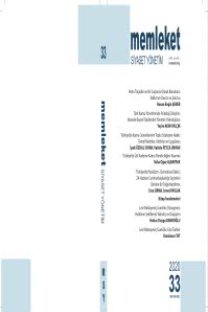Türkiye sanayi stratejisi belgesi temelinde imalat sanayinin yapısal analizi
Bu makalede, Ocak 2011’de Sanayi ve Ticaret Bakanlığı tarafından yayınlanan Türkiye Sanayi Strateji Belgesi 2011-2014’de rekabet gücü incelemesinde öncelik verilen sektörler de dahil olmak üzere Türkiye ekonomisi, sanayi sektörü ve imalat sanayinin genel bir yapısal değerlendirmesi yapılacaktır. Değerlendirmemizde imalat sanayinin alt sektörler bazında genel profili incelenerek, katma değer, sektörel bağlantılar, rekabet gücü, dış ticaret ve teknoloji yoğunluğu açısından durumu analiz edilecektir. Makalede, imalat sanayi sektörlerinin birbirlerini etkileme düzeyleri, talep değişimlerinden etkilenme dereceleri, sektörlerin yaratacağı “katma değer zinciri” Input-Output yaklaşımı ile analiz edilecek olup, ayrıca ülke ihracatında öne çıkan sektörler, hedef pazar ülkeler, rakip ülkeler ve bu ülkeler karşısında ülkemizin rekabet gücü de irdelenecektir.
Structural analysıs of manufacturıng ındustry wıthın the context of strategy document of the Turkısh ındustry
Turkish economy, Turkish industry, and general structural analysis of the manufacturing industry including the specific sectors priority given on examining the competitiveness power in the Strategy Document of the Turkish Industry 2011-2014, will be examined in this study,. General profile of the Turkish manufacturing industry (including its sub-sectors) will be studied and the structure of the Turkish manufacturing industry will be analyzed from the points of value added, sectoral linkages, compe- titiveness, foreign trade and intensity of technology. Additionally, the level of inter-industry effects, demand effects on sectors, ―value added chain‖ by sectors will be examined by the Input-Output approach. Turkish key sectors in terms of export, target market countries and competitors will be analyzed and Turkish competitive advantage will be measured by ―relative competitive index‖ approach
___
- Hazari, B.R. ―Empirical Identification of Key Sectors in the Indian Economy‖, Review of Economics and Statistics, 52, 1970, pp. 173-195.
- Hirschman, A.O., The Strategy of Economic Development, New Haven, CT, Yale University Presss, 1958.
- Küçükkiremitçi, Oktay; Karaca, M. Emin; Eşiyok, B. Ali, Türkiye‟nin İhracatında Öne Çıkan Sektörlerde Temel Pazar Ülkeler, Rakipler ve Rekabet Gücü, Türkiye Kalkınma Bankası, Şubat 2010.
- Küçükkiremitçi, Oktay; Karaca, M. Emin; Eşiyok, B.Ali; Genç, Ömür, Türkiye İmalat Sanayiinde Bölgesel/Yapısal Durum ve Rekabet Gücü Analizleri, Türkiye Kalkınma Bankası, Ağustos 2008.
- Rasmussen, P., Studies in Intersectoral Relations, Copenhagen, Norregard, 1957.
- Reyes, Fidel Aroche, ―Structural Transformations and Important Coefficients in the North American Economies‖, Economic Systems Research, Vol.14., 2002, No. 2.
- Roman L.,Weil, Jr. ―The Decomposition of Economic Production Systems‖, Econometrica, Vol. 36, No. 2, Apr., 1968, pp. 260-278.
- T.C. Sanayi ve Ticaret Bakanlığı, Türkiye Sanayi Stratejisi Belgesi 2011- 2014 (AB Üyeliğine Doğru), Aralık 2010.
- Türkiye İstatistik Kurumu, Yıllık İş İstatistikleri ve Dış Ticaret Verileri, (www.tuik.gov.tr).
- UN Comtrade, (www.comtrade.un.org). United Nations, Studies in Methods Handbook of National Accounting, Series F, No.74, 1999, New York.
- ISSN: 1306-8202
- Yayın Aralığı: Yılda 2 Sayı
- Başlangıç: 2006
- Yayıncı: Yerel Yönetim Araştırma Yardım ve Eğitim Derneği (YAYED)
Sayıdaki Diğer Makaleler
Türkiye sanayi stratejisi belgesi temelinde imalat sanayinin yapısal analizi
Türkiye sanayi stratejisi belgesi üzerine gözlemler
Melda ÖZTÜRK YAMAN, OĞUZ ÖZTÜRK
Türkiye’de liberalizm: bir eklemlenme ideolojisi
12 Eylül askeri darbesinin ekonomi politiği
Avrupa’nın ulusötesi kapitalist sınıfı: Avrupa Sanayiciler Birliği
Türkiye sanayi stratejisi belgesi 2011-2014 (AB üyeliğine doğru): Bir içerik analizi
